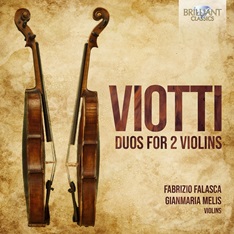Giovanni Battista Viotti, Geiger, Komponist, Impresario und Lehrer, lebte ungefähr zu Zeiten Mozarts. Er hat vor allem für sein Instrument geschrieben. Bekannt sind 32 Konzerte, 70 Sonaten sowie zahlreiche Trios, Quartette und Duos für Streicher. Er übernahm klassische Strukturen. Erst spät gab er seinen Stücken teilweise frühromantische Züge. Sein bewegtes Leben durch ganz Europa lässt sich im Beiheft nachvollziehen.
Die Duos für zwei Violinen bieten sehr adrette, angenehm zu hörende Plaudereien zwischen den gleichartigen Instrumenten, bei denen jeweils ein Instrument führt und das andere dazu ergänzend aktiv ist. Einige Sätze zeichnen sich durch ihren dramatischen Charakter aus. Die beiden Duos op. 9 sind jeweils in vier Sätzen, die aus op. 29 in drei Sätzen komponiert.
Fabrizio Falasca und Gianmaria Melis bieten mit ihrem leichthändig angeregten Spiel ebenso wie mit der immer auf Entwicklung gerichteten musikalischen Ausgestaltung eine ebenso ansprechende wie gehaltvolle Interpretation dieser Duos an, ohne sie jedoch mit Bedeutung zu überladen. So bietet dieses Album nicht nur am Geigenspiel Interessierten beste Gelegenheit, sich dem Wirken von Viotti in diesem kammermusikalischen Bereich zu nähern und seine Brückenbauerrolle zwischen Klassik und Romantik nachzuvollziehen.
Giovanni Battista Viotti, violinist, composer, impresario and teacher, lived around the time of Mozart. He wrote primarily for his instrument. He is known for 32 concertos, 70 sonatas and numerous trios, quartets and duos for strings. He adopted classical structures. It was not until later that he gave his pieces some early romantic features. His eventful life throughout Europe can be traced in the booklet.
The duos for two violins offer very neat, pleasantly audible chats between the similar instruments, in which one instrument leads and the other complements. Some movements are characterized by their dramatic character. The two duos op. 9 are each composed in four movements, those from op. 29 in three movements.
Fabrizio Falasca and Gianmaria Melis offer an interpretation of these duos that is as appealing as it is substantial with their light-hearted, animated playing as well as their musical interpretation, which is always geared towards development, without overloading them with meaning. This album thus offers not only those interested in violin playing the best opportunity to approach Viotti’s work in this area of chamber music and to understand his role as a bridge-builder between the classical and romantic periods.




















